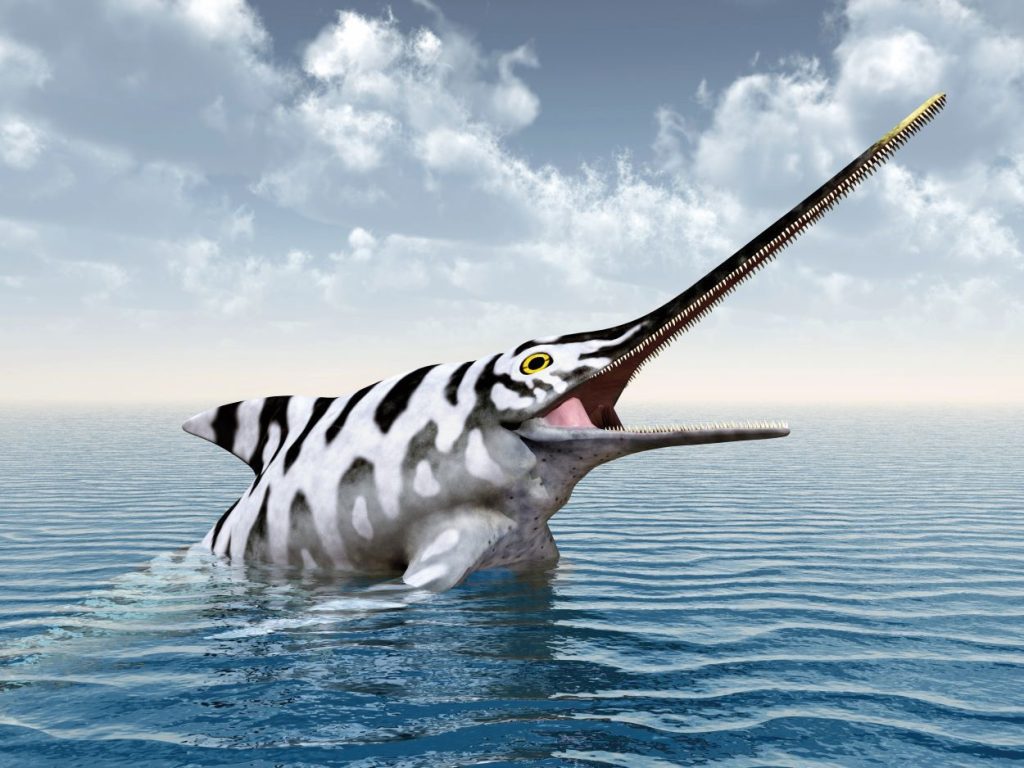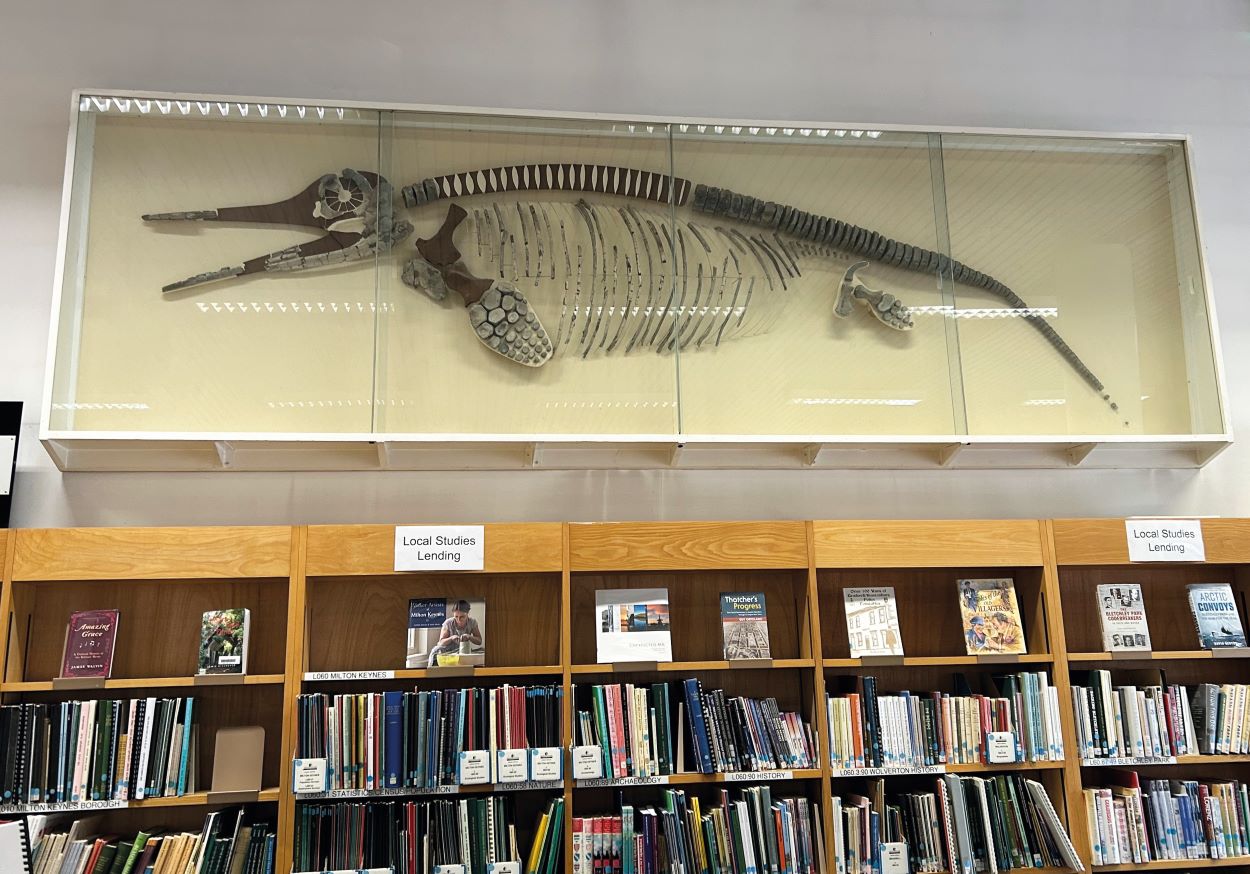The past – and the future – of the ‘Caldecotte Monster’
Posted 4th April 2024
It’s bonkers to think that where we work, rest and play was once at the lowest point of a primeval sea, isn’t it? Where the V and H roads now allow us to move with ease (at least for most of the time) was once part of a warm ocean, home to marine reptiles including Ichthyosaurs. Sammy Jones finds out more about the new city’s very old monster…
Similar to porpoises in appearance, Ichthyosaurs lived in the waters that covered much of continental Europe during the early Jurassic period around 160 million years ago.
While dinosaurs were on the land, Ichthyosaurs were preying on octopus, cuttlefish and squid in the water, travelling at speeds of up to 25 miles an hour in the quest for food. They are believed to have been highly skilled movers and hunters.
Eventually though, these marine reptiles were driven to extinction by climate change. This happened well before the catastrophe that wiped out the dinosaurs. They simply didn’t evolve quickly enough. They were gone forever – almost.
Fossil Mania
Let’s fast forward many millions of years, to the early nineteenth century, and a connection with the Ichthyosaur. Mary Anning – still a young girl – discovered a fossilised skull in the marine fossil beds in the cliffs at Lyme Regis.
Fascination turned into a mission, and over the course of several months, Mary was able to dig the outline of its skeleton – which measured more than five metres in length.
Could it be a crocodile? That was the view of scientists at the time, but following years of debating and study, they realised this impressive discovery was a newly discovered species. They called it Ichthyosaur, meaning fish-lizard.
Mary wasn’t the first to discover the remains of an Ichthyosaur, but hers was the one that caused a stir; it was purchased and displayed publicly in London where it wowed everyone.
Mary’s fascination for fossils continued and over time she became a pioneering palaeontologist, the first professional fossil hunter. She painstakingly documented all that she discovered, with male scientists often purchasing her finds.
Sadly, all too frequently Mary’s work went without the credit deserved. Women were still second class citizens, and this intelligent lady was denied her rightful place.

When Mary died of breast cancer in 1847 she was still afflicted by financial issues, despite her many extraordinary scientific discoveries.
Thankfully, like those many fossils she discovered, her place in history has since been assured. Today, many of her finds can be viewed at The National Museum and, in 2021, a statue of Mary was unveiled in her hometown. Kate Winslet starred as the fossil collector and palaeontologist in the film Ammonite.
Mary spent her time actively searching for Ichthyosaurs, but here in the new city of Milton Keynes, one workman struck fossil gold while working on the excavations for Caldecotte Lake when he just happened to uncover one!
The Milton Keynes Ichthyosaur
Experts from Leicester University were engaged to aid the preservation and conservation of the magnificent creature, of which 75% was recovered.
They spent days mapping out the skeleton, and recording the position of every bone before the whole fossil was lifted, one bone at a time and taken to Leicester for conservation.
Each bone was carefully cleaned and repaired, and because some of the skeleton was encased in hard limestone it had to be carefully sawn out.
The scientific name for the so-called Caldecotte Monster is Ophthalmosaurus, which translates as ‘Eye Lizard.’ It was so-called because of its large eyes. Each was supported by a ring of bone plates and many animals with big eyes have the same features, so too do owls.
Our Ichthyosaur was a fierce predator and one of more than 100 known species which existed between 250 and 90 million years ago.
A newly discovered Ichthyosaur species, estimated to have lived around 218 million years ago, was absolutely huge – with an estimated length of 21 metres. Bigger than the blue whales we know today.
But back to our water ‘monster’, and while he has been a quiet resident of Milton Keynes Library for many years, the launch of our Ancient Gallery will allow us to display it as part of the story of Milton Keynes.
But it’s not as easy as simply removing the display case and taking him to Wolverton. If only it was!
“Conservation has changed in the time he has been resident in CMK, and the fossil must be removed, examined and conserved so we don’t lose any of it, and to prevent it from corroding,” explained Milton Keynes Museum director Bill Griffiths, “We want to restore it so that it will be seen by generations to come. The support structure and display case need to be replaced to meet up-to-date conservation standards too. This will mean that we have to raise at least £25,000 and will have only a month to do it!”
We are aiming to launch a fundraising campaign in association with the Art Fund and give donors a range of experiences and all of them an opportunity to name the Ichthyosaur. Get ready with your suggestions.
“We really hope the public of Milton Keynes will rally and help us to raise the funds necessary for the restoration,” Bill said, “Our supporters are wonderfully loyal, and every penny will count. This is the oldest exhibit we’ll have in the Museum. It is intriguing for all, and will spark the imaginations of children, which is wonderful.
“It will also – for once and for all – silence those critics who say that Milton Keynes has no history. Having something 160 million years old should end that argument for good.
“It’s wonderful that we can have something as remarkable as this in our Ancient Milton Keynes gallery, and that just a few steps away, in another new gallery, we will tell the story of the new town. How about that for variety?
“It’s really great to have the Ichthyosaur coming to take centre stage in the story of Ancient Milton Keynes,” added Bill, “It will welcome visitors very much as Dippy, the Diplodocus, did for decades in the hall of the Natural History Museum.
“The Ichthyosaur and Dippy are about the same age, and while the Ichthyosaur is not a dinosaur, and is not as big, unlike Dippy, it is a real fossil – not just a cast. Most importantly, the Ichthyosaur is also ours – it was found in Milton Keynes, rather than in America like Dippy.
“I hope that for years to come Museum visitors will take the Ichthyosaur to their hearts.”
Milton Keynes Museum is one of the best interactive museums, a perfect outing for all ages, staffed by friendly volunteers, and highly recommended by visitors on TripAdvisor.
This feature was written by Milton Keynes Museum. Find out more about forthcoming events and see our opening times at: miltonkeynesmuseum.org.uk
